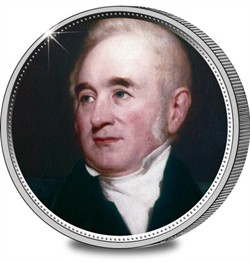
 |
Full name: George Stephenson
Born: 9th June 1781
Place of Birth: Wylam,
Newcastle-Upon-Tyne
Occupation: Railway Engineer
Died: 8th August 1848
|
The revolutionary railway engineer George Stephenson, also known
as the 'Father of Railways', was born on 9th June 1781 in Wylam in
Newcastle-Upon-Tyne. After taking an early interest in
mechanics, Stephenson began his career in the coalmines in North
East England where he managed the machinery and developing steam
engines for use in the mines during the industrial
revolution.
In 1811, Stephenson had a career breakthrough when he discovered
a problem with an engine in one of the mines he was working in and
successfully fixed it, which impressed a group of businessmen who
put him in charge of the machinery at their pits. Stephenson
experimented with steam engines and locomotives and constructed his
first locomotive called the 'Blucher' in 1814.
In 1821, Stephenson became engineer of the construction of the
Stockton and Darlington railway to improve transport links between
the collieries in the North East and London, which became the first
public railway in the world to use steam locomotives. In
1823, construction began and the first iron rail track was
laid. The 26 mile railway line finally opened on 27th
September 1825. Due to the success of the Stockton and
Darlington Railway, Stephenson was made chief engineer of the
construction of the Liverpool to Manchester railway, which was the
first intercity railway in the world and opened on 15th September
1830.
Stephenson's achievements lead him to enter a competition called
the Rainhill Trails at Rainhill, which aimed to find a mechanism
that could pull heavy loads over long distances and Stephenson
successfully constructed the famous 'Rocket' locomotive with his
son Robert. 'Rocket' won the competition after reaching a
record breaking speed of 36 miles per hour and Stephenson became an
engineering genius.
Stephenson constructed further railway lines, such as the Grand
Junction Railway, a line from the Liverpool to Manchester Railway
to Birmingham, and the Manchester to Leeds railway.
Stephenson also invented the rail guage, also known as the
'Stephenson Guage' (4ft and 8.5 inches), which is the world's
standard guage. In 1838, George Stephenson finished the
construction of the first railway from Birmingham to London and he
became president and founder of the Institution of Mechanical
Engineers in 1847. By the time George Stephenson died on 8th
August 1848, railways had revolutionised Great Britain and made it
one of the richest countries in the world.